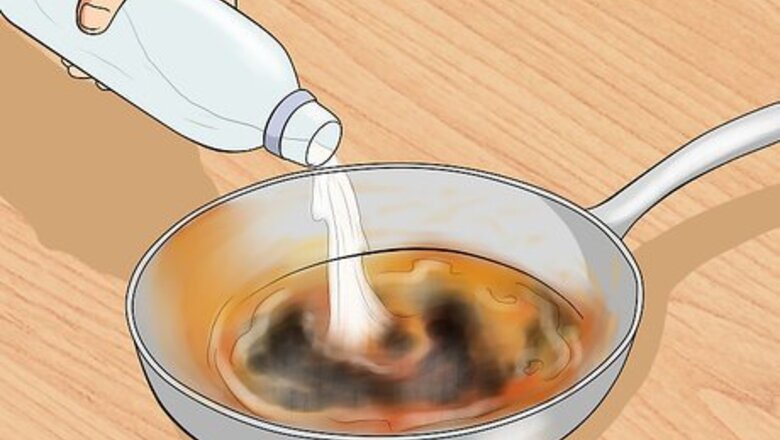
views
Cleaning A Scorched Pan with Detergent
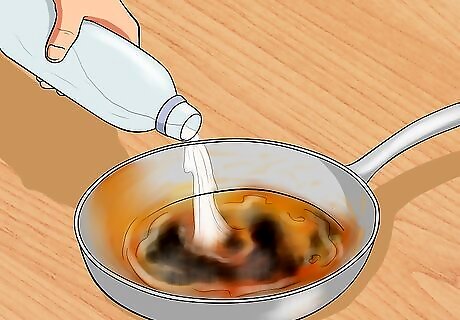
Fill the pan with warm water. Take your dirty pan, and add enough water to cover all of the scorched areas. You should add a two to three inches of additional water to the pan because some of it will evaporate when you heat it. Make sure to dry off the bottom of the pan after you’re done filling it with water. You don’t want to put it on the stove if there are drops of water that may fall onto the burner.
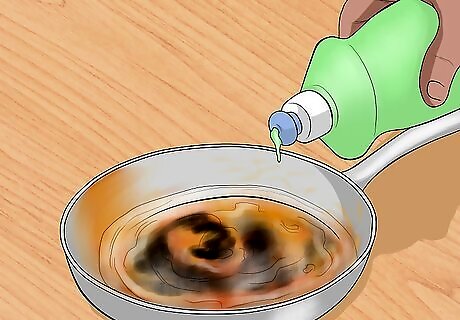
Add several drops of dish detergent. Water alone isn’t enough to remove scorch stains from your pan, so you’ll need to add a cleansing agent to get rid of the burnt film. Squeeze three to four drops of your usual dish detergent into the water and swirl the mixture around to spread the soap throughout the water. For very stubborn scorch marks, you may want to use dishwashing detergent in place of liquid dish soap. You can use a single tablet, several drops of liquid, or 1 to 2 tablespoons of powdered dishwashing detergent.
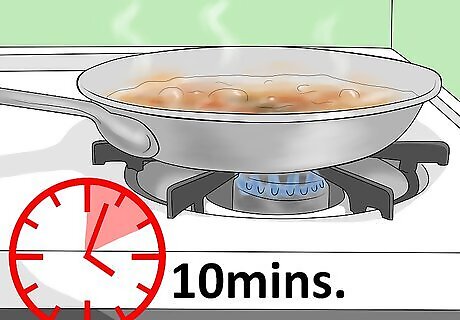
Bring to a boil. Once you’ve combined the detergent and water, place the pan on the stove. Turn the heat up to high, and bring the mixture to a boil. Allow the water and dish detergent to boil for approximately 10 to 15 minutes to help loosen all of the debris from the bottom of the pan. Be sure to boil the water and dish detergent mixture, not just simmer it. You’ll know that it’s boiling when you see large bubbles rising from the bottom of the pan and it’s giving off nearly constant steam.
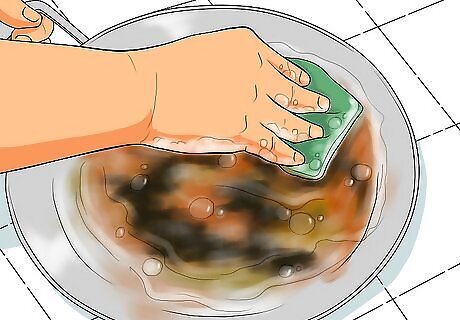
Cool and scrub the pan. After you’ve boiled the contents of the pan for approximately 10 minutes, remove it from the heat and allow it to cool completely, which should take approximately 20 minutes. Discard the water and detergent mixture -- you’ll likely notice that the pan already looks a little cleaner. Next, scrub it with dish detergent and hot water to remove the burnt film and debris. You may need to use some type of scrubbing sponge or tool to remove all of the scorch marks. However, make sure that the pan material won't be damaged. Steel wool pads are effective, but they often scratch the bottom of the pan, which may cause further damage. Sponges that are covered with plastic netting are an ideal alternative because they help scrub away scorch marks but won’t scratch your pan. EXPERT TIP Andrii Gurskyi Andrii Gurskyi House Cleaning Professional Andrii Gurskyi is the owner and founder of Rainbow Cleaning Service, a New York City cleaning company specializing in apartments, homes, and moving cleanup using non-toxic and artificial fragrance free cleaning solutions. Founded in 2010, Andrii and Rainbow Cleaning Service has served over 35,000 customers. Andrii Gurskyi Andrii Gurskyi House Cleaning Professional Our Expert Agrees: Scrubbing the pan with a brillo pad can scratch and damage the finish of the pan, especially non-stick surfaces. The best method is to put dish soap and hot water in the pan and place it on a burner with medium heat. While it's hot, scrape at the pan with a wooden spoon to loosen the debris. If that doesn't work, you can try scrubbing the pan with dryer sheets.
Using Vinegar and Baking Soda for Scorched Pans
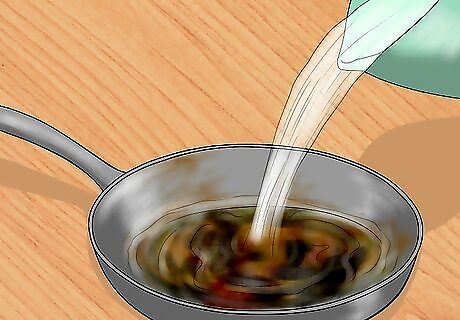
Fill the pan with water. To being the cleaning process, add enough water to your scorched pan to cover the bottom. The amount of water necessary depends on the size of your pan, but 1 cup is a good starting point. If all of the scorched marks aren’t covered, add water until they are.
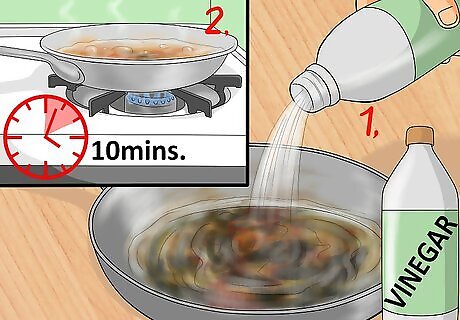
Add vinegar to the water and bring to a boil. Once you have enough water in the pan, it’s time to mix in some vinegar. Pour 1 cup into the water, and gently swirl the pan’s contents to combine the water and vinegar. Place the pan on the stove, and turn the heat up to high to bring the mixture to a boil. Allow it to boil for approximately 10 minutes. The amount of vinegar that you add to the pan will depend on the amount of water that you used. Keep the ratio 1 part water to 1 part vinegar.
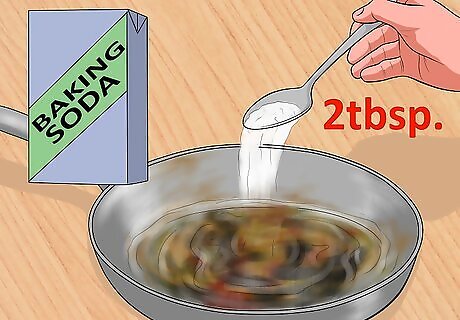
Remove the pan from the stove and add baking soda. When the vinegar and water mixture is finished boiling, remove it from the stove. Sprinkle 2 tablespoons of baking soda into the pan. The baking soda will react with the vinegar, causing fizzing and bubbling that will help loosen the scorched film and debris. The pan will be hot when you add the baking soda, so be careful not to touch it and burn yourself. Allow the baking soda and vinegar to fizz for as long as it takes for the pan to cool. You can also use cream of tartar in place of baking soda to clean a scorched pan. However, you should mix 1 tablespoon of the cream of tartar with 1 cup of water and omit the vinegar before adding it in the pan. While baking soda can work well on a stainless steel pan, you shouldn’t use it or any other alkaline-based cleaning product on anodized aluminum cookware.
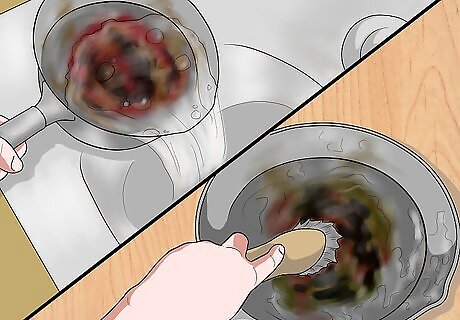
Scrub the pan clean. Once you’re sure that the pan is cool, discard the water, vinegar, and baking soda mixture, and clean the pan with hot, soapy water. Use a sponge with plastic netting or brush to scrub at the bottom of pan, and remove the scorched debris. While it may help to use a sponge with netting or a scrub brush while you’re washing the pan, the baking soda and boiling water should have sufficiently loosened the film and debris so it’s easy to remove. If there are any stubborn scorch marks that won’t scrub free, mix some baking soda with a few drops of water to form a paste. Apply it to the problem spots and allow it to sit for approximately 10 to 15 minutes before cleaning the pan as usual. For extremely stubborn cases, you may need to repeat the entire process one or more times.
Using Oven Cleaner
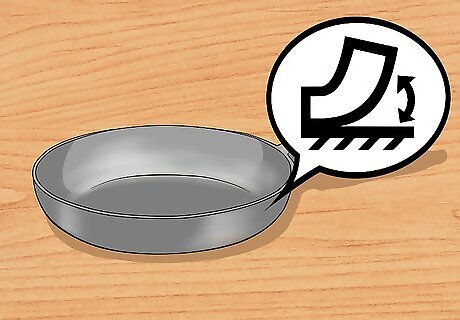
Make sure your pan isn’t non-stick. While oven cleaner can be effective in getting rid of scorch marks, it should be used as a last resort because it is extremely caustic and may discolor the pan. You should never use it on a pan with a non-stick or other protective coating, though, because it will strip off the coating and ruin the pan. Because oven cleaner has the potential to damage cookware, you should only use it if you’ve tried other methods of cleaning your scorched pan and they’ve failed. If you’re planning to toss the pan anyway, it’s a worth a try to use the oven cleaner.
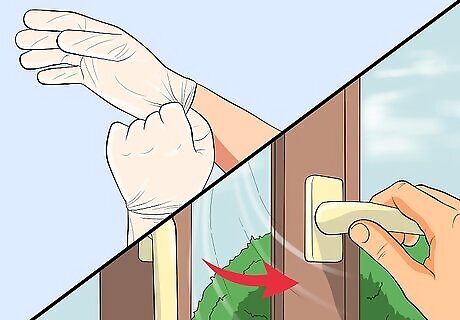
Put on gloves and open a window. Oven cleaner contains caustic chemicals that give off very strong fumes, so it’s important to take safety precautions before you use it. Cover your hands with a pair of rubber gloves to keep your skin safe from the chemicals. You should also make sure that your kitchen is well-ventilated before spraying the oven cleaner, so open a window or two if possible. If you’re especially sensitive to fumes, you may want to wear a dust mask over your nose and mouth when you’re using the oven cleaner. Be sure to read all of the safety warnings on the oven cleaner’s packaging so you’re aware of any other safety precautions that you should take.
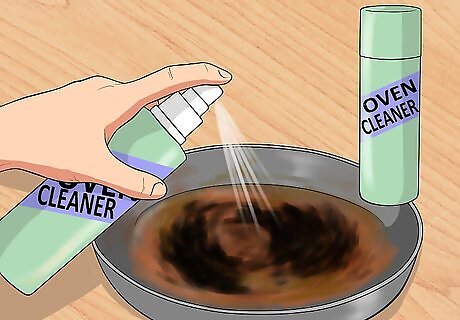
Apply oven cleaner to bottom of the pan. Once you’re prepared to work with the oven cleaner, spray it over the scorched areas of the pan. Because the cleaner is so caustic, you don’t want to use any more than is necessary so cover the bottom of the pan with a light layer. You can use a brush to ensure that it’s spread over the entire pan. While spray oven cleaners formulas are usually the most common, you can also find cream and foam formulas that may work better when you’re cleaning a scorched pan.
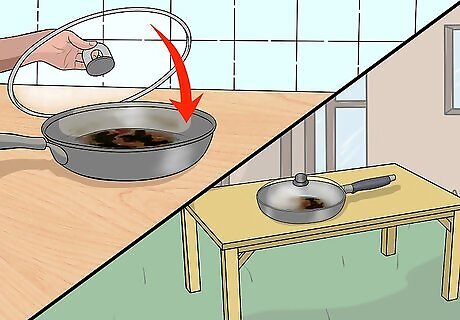
Cover and set outside. In order for the oven cleaner to fully penetrate the scorched areas and loosen the film and debris, you need to let it sit on the pan for at least a half hour. Because of the fumes, it’s best to place the pan outside while the cleaner on it. Cover the pan with a lid, and set it on a table or ledge outside your home. If you don’t have any area outside that you can set the pan, open a window and set it on the window ledge.
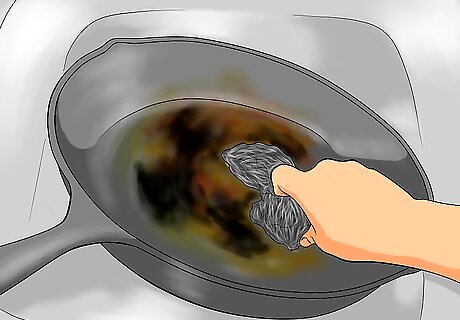
Scrub the pan clean and rinse well. After the cleaner has sat on the pan for approximately a half hour, use a scrub brush or sponge to scour the pan. The scorched film and debris should lift right off. Once you’ve cleaned the pan completely, make sure to rinse it extremely well to ensure that there’s no residue from the oven cleaner left on the surface. If you’re concerned about oven cleaner residue being left behind on the pan, wipe it down with a dry towel after you’ve rinsed it initially to see if anything comes off on the towel. You should definitely rinse it again if you notice any film, though you may want to rinse it again even if the pan is clean to be safe. EXPERT TIP Andrii Gurskyi Andrii Gurskyi House Cleaning Professional Andrii Gurskyi is the owner and founder of Rainbow Cleaning Service, a New York City cleaning company specializing in apartments, homes, and moving cleanup using non-toxic and artificial fragrance free cleaning solutions. Founded in 2010, Andrii and Rainbow Cleaning Service has served over 35,000 customers. Andrii Gurskyi Andrii Gurskyi House Cleaning Professional Try Weiman Bar cleaner when all else fails. Weiman Bar is a stainless steel commercial cleaner that can take scorch marks off nonstick pans and ceramic pans. Use Weiman Bar cleaner with a cloth has a texture in between a brillo pad and a microfiber cloth.













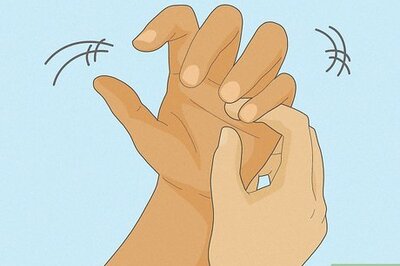



Comments
0 comment